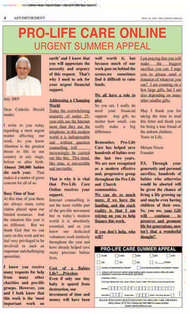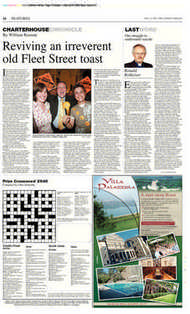Page 5, 22nd July 2005
Page 5

Report an error
Noticed an error on this page?If you've noticed an error in this article please click here to report it.
Tags
Share
Related articles
Sir Alexander Fleming • The Pope's Grief
Pope Benedict Gets A 'change Of Air'
World Youth Day In Spain Raises Hopes
Pope John Paul Ii, Who Is Convalescing In The Italian
Evening Mass On The Mountains
Pope soaks up mountain air and sunshine
Edward Pentin’s Vatican Notebook
‘Isure hope the Holy Father appreciates our efforts,” joked an exhausted Italian lady behind me as we climbed the wooded mountain peak in 90degree heat. “This feels like penance.” Along with 7,000 other pilgrims, most of whom came on wheels, we were on our way to see Pope Benedict XVI give his first Angelus address from his alpine retreat in north-west Italy.
Located 4,500ft above sea level, the Holy Father’s chalet is in an idyllic location. Just a few hundred yards from the typically alpine hamlet of Les Combes, it is surrounded by woodland and meadows, with breathtaking views for miles around, including the towering presence of snow-capped Mont Blanc, Europe’s highest peak, and the expanse of the Aosta Valley below. It therefore came as little surprise to see the Holy Father in very good spirits when, at noon, his slight frame, dazzling in white papal vestments, appeared from behind rows of pine trees to the delight of the crowd, many of whom had been waiting since 7am. He looked well and was relaxed in front of the many pilgrims who had made the journey from northern Italy, France and Switzerland.
Flanked by his private secretary, Mgr Georg Gaenswein, Bishop Giuseppe Anfossi of Aosta, and Cardinal Severino Poletto of Turin, the Holy Father spoke of the value of holidays as a time for prayer, reading and meditation. To hearty cheers, he spoke in the local dialect, wishing the locals a good day and thanking them for their hospitality, and then made an appeal, at the request of the local bishop, to spare the livelihoods of 300 locals whose jobs are threatened.
Security was tight around the “Plan du Saint Père” enclosure from where Pope Benedict XVI delivered his address, and everyone, including those of us emerging from the forests, was searched. But everything ran smoothly, except for when a few unfortunate elder pilgrims fainted in the scorching sunshine.
Pope Benedict later took his second trip into the nearby hamlet, visiting a small and charming chalet-like museum dedicated to John Paul II. The late Pope regularly stayed in Les Combes over a 10-year period, and the museum, built in 1996, is mainly a photographic tribute to the former pontiff. His old hiking gear is also on show – a white ski jacket and trainers, both fashionable in a papal sort of way. Accompanying the Holy Father in his chalet is a small entourage of helpers who include Mgr Gaenswein, two religious sisters and the papal butler, Angelo Gugel. Built in 2003, the residence is well equipped, consisting of a sitting room, bathroom, kitchen, a chapel and two rooms on the ground floor. The Pope’s bedroom, on the first floor, has a balcony that looks out on to Mont Blanc and Valle d’Aosta, and is adjoined by his studio where he is understood to spend much time writing.
A typical day’s holiday for Pope Benedict is, in true Christian tradition, not so much one of relaxation as of activity. He rises early, celebrates Mass with his chalet companions, and then spends four hours in his studio, possibly writing a book on St Benedict’s spirituality, according to his press spokesman.
Lunch at 1pm is followed by a brief rest and walk in the local area, and before supper he settles down to play Mozart or Bach on an upright piano given him by the local mayor.
Such a schedule is in contrast to that of John Paul, who would take rigorous hikes and receive a number of visitors. Benedict prefers to spend time in seclusion and had, midway through his holiday, only received two guests: Cardinal Poletto and his old friend Cardinal Tarcisio Bertone of Genoa. After the first months of what he called “demanding pastoral service” in Rome he wishes to be alone with nature which, he said, is a “book” within reach of everyone that can help man rediscover himself “as a small but at the same time unique” creature. He would, therefore, probably have applauded our efforts to shun the car and climb the mountain to hear him speak, but not the moaning and “mamma mias!” that accompanied our journey.
Could Pope Benedict’s next trip to World Youth Day in Cologne next month mark a significant shift in public opinion in favour of the Church in Germany? Paul Badde, Rome correspondent for the German daily Die Welt, believes that since the death of John Paul II and the election of the first German pontiff since the Middle Ages, Benedict XVI’s visit will come at a turning point in the history of the German Church.
Badde, argues that the German people are now becoming aware that “something went wrong” in the period Chesterton called “the shipwreck of Christendom”. Sceptical press reports are saying “only five per cent” of the population had come back to the Church since Benedict’s election.
“That’s actually a lot,” countered Badde. “An enormous shift.”
blog comments powered by Disqus

















